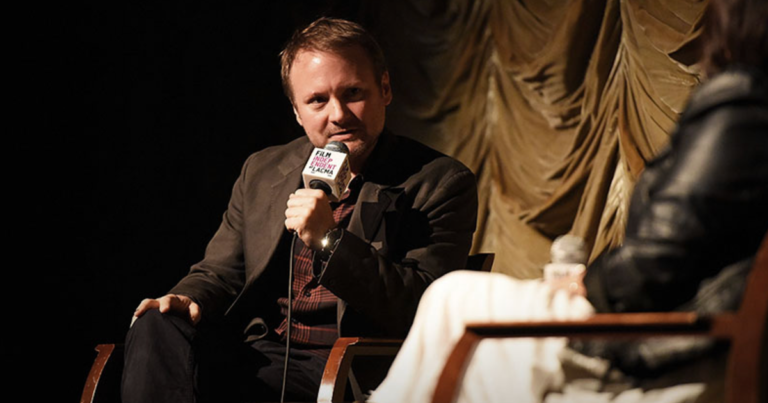By Tom Dever · January 20, 2018

The Film Independent screening of American Graffiti at LACMA followed by a Q&A with director Rian Johnson felt like a special Star Wars rendition of six degrees of separation. Rian Johnson, director of the latest Star Wars release, The Last Jedi, chose to screen American Graffiti, the second film directed by Star Wars creator George Lucas and starring Ron Howard, who, of course, is directing Solo: A Star Wars Story, a space western following the adventures of a young Han Solo, the character made famous by Harrison Ford, who is also in American Graffiti.
You with me?
While it would be fun to compare and contrast the similar deconstruction of Lucas and Johnson’s high school careers in their respective features American Graffiti and Brick, it’s too hard to ignore the striking similarities between Lucas’s second feature and his iconic franchise.
At first glance, a film following recent graduates over one night in early 60s Modesto and a space opera set in a galaxy far, far away don’t have much in common. But putting Lucas’s career in perspective and acknowledging that, like Han, American Graffiti shot first, the parallels are striking.
1. Coming of Age and Leaving Home
In the original Star Wars (A New Hope, if you must), a young Luke Skywalker gazes at the binary suns on his home planet of Tatooine, dreaming of the infinite world beyond. Luke’s coming of age and leaving the world he is familiar with is the primary narrative of the first Star Wars film.
In American Graffiti, we have two similar stories that move in opposite directions. Ron Howard’s Steve dreams of leaving Modesto and heading east for college and life beyond what he knows. Richard Dreyfuss’s Curt, on the other hand, spends much of the film resisting the idea of leaving the life he knows, only to leave at the end of the film when Steve decides to stay.
The shot of Curt gazing out of the airplane window in the film’s final moment is quite reminiscent of Luke gazing at those two suns.
2. Visions of Mysterious Female in White
“Help me Obi Wan, you’re my only hope.” With those fateful words and the fleeting image of Carrie Fisher’s Princess Leia, Luke’s journey is set in motion. Despite no frame of reference or understanding of the message, he is enthralled by this beautiful woman dressed in white and seeks to find her and this Obi Wan she is referring to.
Early in American Graffiti, Curt sees a beautiful blonde woman in a white Thunderbird. Their eyes meet at a red light and she mouths “I love you.” Curt is enthralled and spends the remainder of the film desperately trying to find this woman and decipher her message.
Mysterious message? Check. Beautiful woman in white? Check. Catalyst for teenage male’s coming of age narrative? Check.
3. The Soundtracks
There isn’t much left to be said about Star Wars’ iconic score and epic opening sequence. If you can’t immediately hum the main theme, Imperial March, or even the Jedi Theme, then I’m guessing The Script Lab isn’t really your thing.
You can’t say enough about how crucial the sound and music is to American Graffiti as well. In a similar vein, the film smashes into its title sequence with “Rock Around the Clock” by Bill Haley & His Comets in place of John Williams’ score.
While the original score and distinct sound effects were crucial to Star Wars resonating with fans, the sheer scope of American Graffiti‘s pop soundtrack is equally as vital to its establishing a tone and time.
4. Vehicles as Characters
To say George Lucas is a gearhead would be an understatement, as the vehicles have been vital to all of his projects. While Luke, Leia, Han, Darth Vader and Yoda are iconic elements of the franchise, so too is the Millennium Falcon, the TIE Fighters, the Rebel’s X-Wing fighters, the Imperial Star Destroyers, the AT-AT Walkers on Hoth, and (forgive me for acknowledging the prequel trilogy) even the podracers.
So it makes sense that so much attention is paid to the cars in American Graffiti. The aforementioned white Thunderbird obviously plays a crucial part in the story, but so too do Harrison Ford’s 55 Chevy, Terry the Toad’s ’58 Impala, The Pharaohs’ 51 Mercury and, of course, Millner’s ’32 Deuce Coupe.
The amount of detail placed in the cars down to the color and sounds of their engines makes them seem like characters unto themselves.
5. Han Solo before Han Solo
The irony of a Han Solo origin film coming out next year is that we essentially already have one with American Graffiti. Stop me when this sounds familiar. You have an obnoxious self-assured racer in an iconic transport who constantly runs afoul with the law, constantly bickers with a younger female adversary/love interest, has a semi-coherent sidekick and places most of his energy into maintaining his coolness at all times.
As Rian Johnson praised Harrison Ford that night, “These little looks he gives just slay!”
Weirdly enough, it is not Harrison Ford’s Bob Falfa, but Paul Le Mat’s John Millner that served as the undeniable precursor and inspiration for Han Solo.
 See any similarities we missed? Disagree with my connecting of the dots? Let us know in the comment section!
See any similarities we missed? Disagree with my connecting of the dots? Let us know in the comment section!
 Tom Dever writes for The Script Lab.
Tom Dever writes for The Script Lab.
For all the latest from The Script Lab, be sure to follow us on Twitter, Facebook, and Instagram.
Images taken from Film Independent’s recap of the same event.